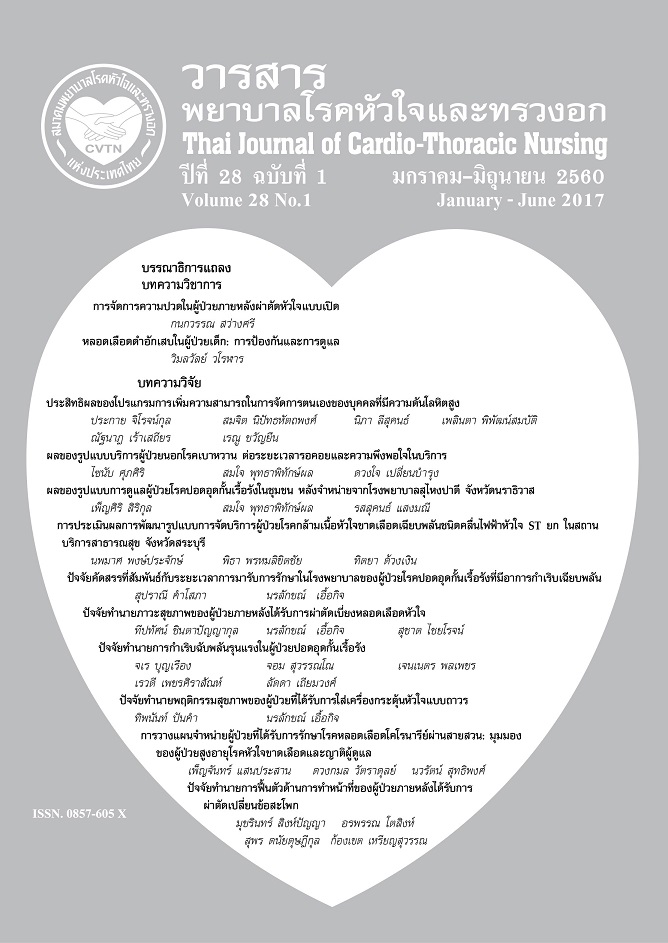ปัจจัยทำนายการฟื้นตัวด้านการทำหน้าที่ของผู้ป่วย ภายหลังได้รับการผ่าตัดเปลี่ยนข้อสะโพก
คำสำคัญ:
การผ่าตัดเปลี่ยนข้อสะโพก, ระดับฮีโมโกลบินในกระแสเลือด, ภาวะโรคร่วม, ภาวะซึมเศร้า, การฟื้นตัวด้านการทำหน้าที่, hip arthroplasty, hemoglobin level, comorbidity, depression, functional recoveryบทคัดย่อ
การศึกษาวิจัยนี้เป็นการวิจัยเชิงบรรยายเพื่อศึกษาอำนาจการทำนายของระดับฮีโมโกลบินในกระแสเลือด ภาวะโรคร่วม และภาวะซึมเศร้าต่อการฟื้นตัวด้านการทำหน้าที่ของผู้ป่วยภายหลังได้รับการผ่าตัดเปลี่ยนข้อสะโพก กลุ่มตัวอย่างได้รับการคัดเลือกตามเกณฑ์การคัดกลุ่มตัวอย่างจำนวน 80 ราย มีอายุตั้งแต่ 18 ปีขึ้นไป เข้ารับการผ่าตัดเปลี่ยนข้อสะโพกเป็นครั้งแรกในโรงพยาบาลตติยภูมิ 3 แห่ง เก็บข้อมูลในระยะก่อนผ่าตัดดังนี้ ระดับฮีโมโกลบินในกระแสเลือดล่าสุดก่อนผ่าตัด ภาวะโรคร่วม ASA classification ประเมินภาวะซึมเศร้าโดยใช้แบบสอบถามภาวะซึมเศร้า เก็บข้อมูลการฟื้นตัวด้านการทำหน้าที่ภายหลังผ่าตัดในวันที่ผู้ป่วยมาตรวจตามนัดครั้งแรก ด้วยแบบประเมิน Harris Hip Score วิเคราะห์ข้อมูลด้วยสถิติพรรณนาและสถิติถดถอยพหุคูณแบบขั้นตอน
ผลการศึกษาพบว่า กลุ่มตัวอย่างมีระดับฮีโมโกลบินในกระแสเลือดเฉลี่ย 12.09 กรัมต่อเดซิลิตร ( SD ± 1.80) มี ASA physical status Class 2 มากที่สุด (ร้อยละ 58.8) คะแนนภาวะซึมเศร้าเฉลี่ย 10.56 ( SD ± 7.50 ) คะแนนการฟื้นตัวด้านการทำหน้าที่เฉลี่ย 58.39 (SD ± 8.60) ส่วนใหญ่การฟื้นตัวด้านการทำหน้าที่อยู่ในระดับต่ำ (ร้อยละ 90) ภาวะโรคร่วมสามารถทำนายการฟื้นตัวด้านการทำหน้าที่ของผู้ป่วยภายหลังได้รับการผ่าตัดเปลี่ยนข้อสะโพกได้ร้อยละ 6.8 (R2 = 0.068, p < 0.05) โดยภาวะโรคร่วมกับภาวะซึมเศร้าสามารถร่วมทำนายการฟื้นตัวด้านการทำหน้าที่ของผู้ป่วยภายหลังได้รับการผ่าตัดเปลี่ยนข้อสะโพกได้ร้อยละ 13.1 (R2 = 0.131, p < 0.05) สำหรับระดับฮีโมโกลบินในกระแสเลือด การศึกษาครั้งนี้พบว่า ไม่สามารถทำนายการฟื้นตัวด้านการทำหน้าที่ของผู้ป่วยภายหลังได้รับการผ่าตัดเปลี่ยนข้อสะโพกได้
ผลการศึกษาครั้งนี้สามารถช่วยให้ผู้ป่วยมีการฟื้นตัวด้านการทำหน้าที่ภายหลังผ่าตัดเปลี่ยนข้อสะโพกได้ หากผู้ป่วยได้รับการประเมินความรุนแรงของภาวะโรคร่วม คัดกรองภาวะซึมเศร้าและมีการดำเนินการแก้ไขหรือควบคุมภาวะโรคร่วม ภาวะซึมเศร้า ไม่ให้รุนแรงขึ้นก่อนได้รับการผ่าตัดเปลี่ยนข้อสะโพก
Factor predicting functional recovery of patients undergoing hip arthroplasty
The propose study was to examine predictive power of hemoglobin level, comorbidity and depression on the functional recovery among patients undergoing hip arthroplasty. The sample comprised 80 patients who received primary hip arthroplasty at tertiary care hospitals in Bangkok, Thailand. The majority of patients were female (61.2%) with an average age of 66.14 years (SD ± 14.28 years). The American Society of Anesthesiologist (ASA) physical status classification was used to measure patients, comorbidity. The Center for Epidemiologic Studies-Depression (CES-D) instrument (Thai version) was used to measure depression and Harris Hip Score was used to measure functional recovery. The data were analyzed using descriptive statistic and stepwise multiple regression analysis.
The result showed that hemoglobin mean level was 12.09 g/dl (SD ± 1.80 g/dl). The majority of patients (72.2%) had chronic illnesses and 53.3% had ASA physical status of class 2. The average depression score was 10.56 (SD ± 7.50) and 10% of the patients had a major depressive disorder. The average Harris Hip Score was 58.39 (SD ± 8.60). Almost all of the patients (90%) had poor functional recovery. Multiple regression analysis showed that comorbidity predicted functional recovery at 6.8% (R2 = 0.068, p < 0.05). Comorbidity and depression could co-predict functional recovery at 13.1% (R2 = 0.131, p < 0.05) while hemoglobin levels could not predict.
It is recommended that during the transition process, patients who had comorbidity and depression would experience delayed functional recovery. Accordingly, prior to surgery, they should be screened for chronic illnesses and levels of depression. If these problems were found, they should be closely monitored and receive appropriate care to facilitate a smooth transition after hip arthroplasty.
ดาวน์โหลด
รูปแบบการอ้างอิง
ฉบับ
ประเภทบทความ
สัญญาอนุญาต
บทความนี้ยังไม่เคยตีพิมพ์หรืออยู่ในระหว่างส่งไปตีพิมพ์ในวารสารอื่น ๆ มาก่อน และกองบรรณาธิการขอสงวนสิทธิ์ในการตรวจทาน และแก้ไขต้นฉบับตามเกณฑ์ของวารสาร ในกรณีที่เรื่องของท่านได้ได้รับการตีพิมพ์ในวารสารฉบับนี้ถือว่าเป็น ลิขสิทธิ์ของวารสารพยาบาลโรคหัวใจและทรวงอก






